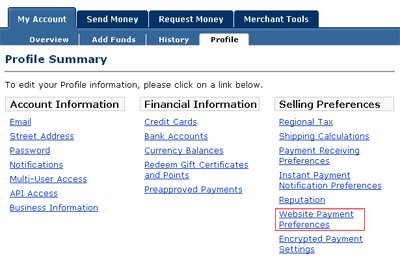This article contains 3 section ...
I. General Architecture
II. PayPal Settings
III. PHP Integration
The integration uses CURL to connect to PayPal server. I assume you are familiar with CURL functions for PHP. You can visit PHP manual at
http://sg.php.net/manual/en/ref.curl.php for more information.
I. GENERAL ARCHITECTURE
This is my proposed architecture...
After the checkout process in your website, you redirect the buyer to the PayPal website to make payment. After making the payment (or cancel the payment), PayPal will redirect the buyer back to your website.
During the checkout process, you may...
- Calculate product total and shipment cost
- Gather buyer delivery and billing information
At point A you may...
- Store the order information temporary in database (with status set as "Pending"). This can help to prevent information lost while PayPal redirect the buyer back to your website.
- Submit payment information to PayPal website through HTTP Post. (Will be explained later)
- We will assume this page as
http://www.yourmerchant.com/saveorder.phpPoint B is where PayPal return to your website. Here you will need to check the payment status by sending request to PayPal server. (Will be explainted later). After checking the status (Success or Failed), you can update the status of the order and reroute your buyer to either a thankyou page or cancel page. We will assume this page as
http://www.yourmerchant.com/paypal_return.phpNote that PayPal will redirect the buyer to a cancel page if he/she click the "Cancel" link in PayPal page. We will assume this page as
http://www.yourmerchant.com/paypal_cancel.php
II. PayPal SettingsYou will need to have PayPal premier or business to accept online payment.
For web developers, you can test the integration using the testing environment called sanbox. To setup developer account...
1. Visit developer.paypal.com
2. Sign-up a developer account and login to PayPal Developer Center
3. Create new PayPal Premier/Business account at SandBox
To setup PayPal to accept website payment...
1. Login to PayPal at
www.paypal.com or
http://www.sandbox.paypal.com/ (Testing environment)
2. From the "Profile" section under "My Account" tab, click "Website Payment Preferences"

3. In "Website Payment Preferences" page, make the following changes and save the setting
- Auto Return to On
- Return URL to the absolute URL of the page you want PayPal to return to
- Payment Data Transfer to On
- PayPal Account Optional to On. This will allow your buyer to make payment directly using Credit Card if he/she does not have a PayPal account.
4. Visit back the "Website Payment Preferences" page and copy the "Identity Token" under "Payment Data Transfer". We will use this token to send request to PayPal at point B of General Architecture.
III. PHP IntegrationThis is the sample code for saveorder.php
$desc = //set to the order description to be appear on the PayPal website;
$orderno = //set to unique order number;
$nettotal = //set to productTotal + shipmentFee + tax;
$_SESSION["ss_last_orderno"] = $orderno;
//Save order information to database using the unique order number with status set as Pending...
$url = "https://www.sandbox.paypal.com/cgi-bin/webscr"; //Test
//$url = "https://www.paypal.com/cgi-bin/webscr"; //Live
$ppAcc = "leepeng@forecepts.com"; //PayPal account email
$cancelURL = "http://www.yourmerchant.com/paypal_cancel.php";
$returnURL = "http://www.yourmerchant.com/paypal_return.php";
$buffer =
"<form action='$url' method='post' name='frmPayPal'>\n".
"<input type='hidden' name='business' value='$ppAcc'>\n".
"<input type='hidden' name='cmd' value='_xclick'>\n".
"<input type='hidden' name='item_name' value='$desc'>\n".
"<input type='hidden' name='item_number' value='$orderno'>\n".
"<input type='hidden' name='amount' value='$nettotal'>\n".
"<input type='hidden' name='no_shipping' value='1'>\n".
"<input type='hidden' name='currency_code' value='USD'>\n".
"<input type='hidden' name='handling' value='0'>\n".
"<input type='hidden' name='cancel_return' value='$cancelURL'>\n".
"<input type='hidden' name='return' value='$returnURL'>\n".
"</form>\n".
"<script language='javascript'>document.frmPayPal.submit();"</script>\n";
echo($buffer);
This is the sample code for paypal_return.php
$orderno = $_SESSION["ss_last_orderno"];
$ppAcc = "leepeng@forecepts.com";
$at = "Kjz22GB8NmlPJNxrGl1ha6z4tkU4DYsH1-_zh5KuZuOqy8CUIUPBkCIKCBy"; //PDT Identity Token
$url = "https://www.sandbox.paypal.com/cgi-bin/webscr"; //Test
//$url = "https://www.paypal.com/cgi-bin/webscr"; //Live
$tx = $_REQUEST["tx"]; //this value is return by PayPal
$cmd = "_notify-synch";
$post = "tx=$tx&at=$at&cmd=$cmd";
//Send request to PayPal server using CURL
$ch = curl_init ($url);
curl_setopt ($ch, CURLOPT_RETURNTRANSFER, 1);
curl_setopt ($ch, CURLOPT_HEADER, 0);
curl_setopt ($ch, CURLOPT_TIMEOUT, 30);
curl_setopt ($ch, CURLOPT_POST, 1);
curl_setopt($ch,CURLOPT_SSL_VERIFYPEER,FALSE);
curl_setopt ($ch, CURLOPT_POSTFIELDS, $post);
$result = curl_exec ($ch); //returned result is key-value pair string
$error = curl_error($ch);
if (curl_errno($ch) != 0) //CURL error
exit("ERROR: Failed updating order. PayPal PDT service failed.");
$longstr = str_replace("\r", "", $result);
$lines = split("\n", $longstr);
//parse the result string and store information to array
if ($lines[0] == "SUCCESS") {
//successful payment
$ppInfo = array();
for ($i=1; $i<count($lines); $i++) {
$parts = split("=", $lines[$i]);
if (count($parts)==2) {
$ppInfo[$parts[0]] = urldecode($parts[1]);
}
}
$curtime = gmdate("d/m/Y H:i:s");
//capture the PayPal returned information as order remarks
$oremarks =
"##$curtime##\n".
"PayPal Transaction Information...\n".
"Txn Id: ".$ppInfo["txn_id"]."\n".
"Txn Type: ".$ppInfo["txn_type"]."\n".
"Item Number: ".$ppInfo["item_number"]."\n".
"Payment Date: ".$ppInfo["payment_date"]."\n".
"Payment Type: ".$ppInfo["payment_type"]."\n".
"Payment Status: ".$ppInfo["payment_status"]."\n".
"Currency: ".$ppInfo["mc_currency"]."\n".
"Payment Gross: ".$ppInfo["payment_gross"]."\n".
"Payment Fee: ".$ppInfo["payment_fee"]."\n".
"Payer Email: ".$ppInfo["payer_email"]."\n".
"Payer Id: ".$ppInfo["payer_id"]."\n".
"Payer Name: ".$ppInfo["first_name"]." ".$ppInfo["last_name"]."\n".
"Payer Status: ".$ppInfo["payer_status"]."\n".
"Country: ".$ppInfo["residence_country"]."\n".
"Business: ".$ppInfo["business"]."\n".
"Receiver Email: ".$ppInfo["receiver_email"]."\n".
"Receiver Id: ".$ppInfo["receiver_id"]."\n";
//Update database using $orderno, set status to Paid
//Send confirmation email to buyer and notification email to merchant
//Redirect to thankyou page
}
//Payment failed
else {
//Delete order information
//Redirect to failed page
}
Below are the websites done by me which uses PayPal
- www.anglers-proshop.com
- www.fishnpetpro.com
- www.admixture.com
If you are interest to acquire eCommerce service, pls feel free to contact my company at info@forecepts.com

